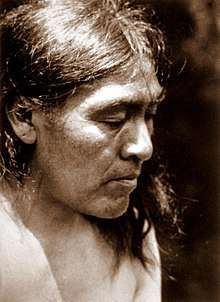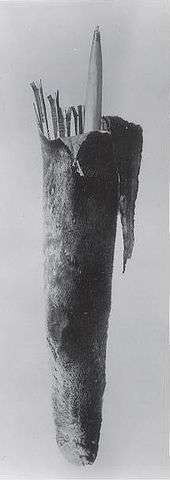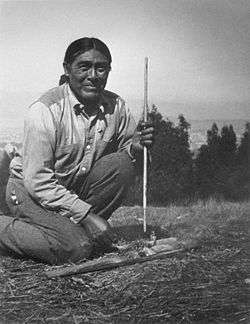Ishi
| Ishi | |
|---|---|
 | |
| Born |
Unknown (first documented in 1865) Ophir, California, U.S. |
| Died |
March 25, 1916 (age 55-56) University of California, Berkeley, U.S. |
Ishi (c. 1861 – March 25, 1916) was the last known member of the Native American Yahi people from the state of California in the United States. The rest of the Yahi (as well as many members of their parent tribe, the Yana) were killed in the California genocide in the 19th century. Ishi, who was widely acclaimed as the "last wild Indian" in America, lived most of his life isolated from modern American culture. In 1911, aged 50, he emerged near the foothills of Lassen Peak in Northern California.
Ishi, which means "man" in the Yana language, is an adopted name. The anthropologist Alfred Kroeber gave him this name because in the Yahi culture, tradition demanded that he not speak his own name until formally introduced by another Yahi.[1] When asked his name, he said: "I have none, because there were no people to name me," meaning that there was no other Yahi to speak his name on his behalf.
Ishi was taken in by anthropologists at the University of California, Berkeley, who both studied him and hired him as a research assistant. He lived most of his remaining five years in a university building in San Francisco.
Biography
Early life

In 1865,[2] Ishi and his family were attacked in the Three Knolls Massacre, in which 40 of their tribesmen were killed. Although 33 Yahi survived to escape, cattlemen killed about half of the survivors. The last survivors, including Ishi and his family, went into hiding for the next 44 years, and their tribe was popularly believed to be extinct.[3] Prior to the California Gold Rush of 1848–1855, the Yahi population numbered 404 in California, but the total Yana numbered 2,997.[4]
The gold rush brought tens of thousands of miners and settlers to northern California, putting pressure on native populations. Gold mining damaged water supplies and killed fish; the deer left the area. The settlers brought new diseases such as smallpox and measles.[5] The northern Yana group became extinct while the central and southern groups (who later became part of Redding Rancheria) and Yahi populations dropped dramatically. Searching for food, they came into conflict with settlers, leading to bounties on the natives by the settlers. Prices included 50 cents per scalp and 5 dollars per head. In 1865, the massacre began while the Yahi slept in bed.
Richard Burrill wrote, in Ishi Rediscovered:
"In 1865, near the Yahi’s special place, Black Rock, the waters of Mill Creek turned red at the Three Knolls Massacre. 'Sixteen' or 'seventeen' Indian fighters killed about forty Yahi, as part of a retaliatory attack for two white women and a man killed at the Workman’s household on Lower Concow Creek near Oroville. Eleven of the Indian fighters that day were Robert A. Anderson, Hiram Good, Sim Moak, Hardy Thomasson, Jack Houser, Henry Curtis, his brother Frank Curtis, as well as Tom Gore, Bill Matthews, and William Merithew. W. J. Seagraves visited the site, too, but some time after the battle had been fought.
Robert Anderson wrote, 'Into the stream they leaped, but few got out alive. Instead many dead bodies floated down the rapid current.' One captive Indian woman named Mariah from Big Meadows (Lake Almanor today), was one of those who did escape. The Three Knolls battle is also described in Theodora Kroeber’s Ishi in Two Worlds, but more information has come to light. It is estimated that with this massacre, Ishi's entire cultural group, the Yana/Yahi, may have been reduced to about sixty individuals. From 1859 to 1911, Ishi's remote band became more and more infiltrated by non-Yahi Indian representatives, such as Wintun, Nomlaki, and Pit River individuals.
In 1879, the infamous Indian boarding schools started in California. The ranks of embittered reservation renegades who became the new "boys in the hills", to quote Robert Anderson, became a direct function of what new attacks or removal campaigns that the volunteers and military troops elected to carry out against the northern California Indian tribes during that time."[6]
In late 1908, a group of surveyors came across the camp inhabited by two men, a middle-aged woman, and an elderly woman—Ishi, his uncle, his younger sister, and his mother, respectively. The former three fled while the latter hid herself in blankets to avoid detection, as she was sick and unable to flee. The surveyors ransacked the camp and Ishi's mother died soon after his return. His sister and uncle never returned.
Walking into the modern world
After the attack, Ishi spent three more years in the wilderness, alone. Finally, starving and with nowhere to go, at around the age of 50, on August 29, 1911, Ishi walked out into the western world.[3] He was captured attempting to forage for meat near Oroville, California, after forest fires in the area.[7]
"After the native was noticed by townspeople, the local sheriff took the man into custody for his own protection." The "wild man" caught the imagination and attention of thousands of onlookers and curiosity seekers. Professors at the University of California, Berkeley, Museum of Anthropology—now the Phoebe A. Hearst Museum of Anthropology (PAHMA)—read about him and brought him to their facility,[7] then housed on the University of California, San Francisco campus in an old law school building. Studied by the university, Ishi also worked with them as a research assistant and lived in an apartment at the museum for most of the remaining five years of his life. In June 1915, he temporarily lived in Berkeley with the anthropologist Thomas Talbot Waterman and his family.[8]
Ishi revealing Yahi culture
Waterman and Alfred L. Kroeber, director of the museum, studied Ishi closely over the years and interviewed him at length to help them reconstruct Yahi culture. He described family units, naming patterns, and the ceremonies that he knew, but much tradition had been lost because there were few older survivors in the group in which he was raised. He identified material items and showed the techniques by which they were made. Ishi provided valuable information on his native Yana language, which was recorded and studied by the linguist Edward Sapir, who had previously done work on the northern dialects.
Illness and death
Ishi, having come to live in San Francisco and lacking immunity to the "diseases of civilization", was often ill. He was treated by a Professor of Medicine at UCSF, Saxton T. Pope. Pope became close friends with Ishi, and learned from him how to make bows and arrows in the Yahi way. He and Ishi often hunted together.
Ishi died of tuberculosis on March 25, 1916. It is said his last words were "You stay. I go." [7] His friends at the university initially had tried to prevent an autopsy on Ishi's body since the body was to be kept intact according to Yahi tradition, but the doctors at the University of California medical school performed one before Waterman was able to stop it. Ishi's brain was preserved and the body cremated. Included alongside his remains were "one of his bows, five arrows, a basket of acorn meal, a boxful of shell bead money, a purse full of tobacco, three rings, and some obsidian flakes." Ishi's remains were interred at Mount Olivet Cemetery in Colma, near San Francisco,[9] but his brain was put in a deerskin-wrapped Pueblo Indian pottery jar and sent to the Smithsonian Institution by Kroeber in 1917, where it remained until August 10, 2000, when descendants of the Redding Rancheria and Pit River tribes received the brain, according to both the letter and the spirit of the National Museum of the American Indian Act of 1989 (NMAI).[10] According to Robert Fri, director of the National Museum of Natural History, "Contrary to commonly-held belief, Ishi was not the last of his kind. In carrying out the repatriation process we learned that as a Yahi–Yana Indian his closest living descendants are the Yana people of northern California."[11] Once the brain and remains were returned, further information about them has remained private.[10]
Possible multi-ethnicity

In 1994, Steven Shackley of UC Berkeley heard a paper by Jerald Johnson, who noted morphological evidence that Ishi's facial features and height were more typical of the Wintu and Maidu. He theorized that under pressure of diminishing populations, members of groups that were once enemies may have intermarried to survive. To further support this, Johnson presented oral histories from the Wintu and Maidu that told of the tribes' intermarrying with the Yahi.[12] The debate on this has not been definitively settled, however, and the possibility of establishing the circumstances of his birth probably died with him.
In 1996, Shackley announced work based on a study of Ishi's projectile points and those of the northern tribes. He had found that points made by Ishi were not typical of those recovered from historical Yahi sites. Because Ishi's production was more typical of points of the Nomlaki or Wintu tribes and markedly dissimilar to those of Yahi, Shackley suggested that Ishi may have been only half Yahi and of mixed ancestry, related to another of the tribes.[12] He based his conclusion on a study of the points that Ishi had made compared to others held by the museum from the Yahi, Nomlaki and Wintu cultures. Among Ishi's techniques was the use of what is now known in flintknapping circles as an Ishi stick, used to run long pressure flakes.[13] As it was a traditional technique of the Nomlaki and Wintu tribes, the finding suggests Ishi may have learned the skill directly from a male relative from one of those tribes. Also small groups, they lived close to the Yahi lands and were traditional competitors and enemies of the Yahi.[13]
Legacy
Buildings and land
- Due to a campaign by Gerald Vizenor, the courtyard in Dwinelle Hall at the University of California, Berkeley was renamed "Ishi Court".[14]
- The Ishi Wilderness Area in northeastern California, believed to be the ancestral grounds of his tribe, is named in his honor.
Toolmaking
- Ishi is revered by flintknappers as probably one of the last two native stone tool makers in North America. His techniques are widely imitated by knappers, and ethnographic accounts of his toolmaking are considered to be the Rosetta Stone of lithic tool manufacture.[15]
Works of art, media, and entertainment
Audio recordings
- Kroeber and Waterman's 148 wax cylinder recordings (totaling 5 hours and 41 minutes) of Ishi speaking, singing, and telling stories in the Yahi language were selected by the Library of Congress as a 2010 addition to the National Recording Registry, which selects recordings annually that are "culturally, historically, or aesthetically significant".[16]
Films
- Ishi: The Last of His Tribe (airdate December 20, 1978), with Eloy Casados in the title role, was telecast on NBC. The film was written by Christopher Trumbo.[17]
- The Last of His Tribe (1992), with Graham Greene as Ishi, was also produced as a TV movie.[18]
- Ishi: The Last Yahi (1992), is an award-winning documentary film by Jed Riffe.[19][20]
- In Search of History: Ishi, the Last of His Kind (1998), is a 1998 television documentary.
Literature
- Ishi in Two Worlds (1961) by the anthropologist Theodora Kroeber, also the wife of Alfred Kroeber, popularized Ishi's story in her book. She worked with her husband's notes and comments to create the story of a man she had never met, publishing it after Alfred's death.
- Ishi: Last of His Tribe (1964) by Theodora Kroeber is a shorter, partially fictionalized version of the story.
- Ishi the Last Yahi: A Documentary History (1981), edited by Robert Heizer and Theodora Kroeber, contains additional scholarly materials.[21]
- The Last Yahi: A Novel About Ishi (2000) is a novel by Lawrence Holcomb.[22]
- Ishi in Three Centuries (2003), edited by anthropologists Clifton and Karl Kroeber, Theodora and Alfred Kroeber's sons,[23] is the first scholarly book on Ishi to contain essays by Native Americans. Native writers, such as Gerald Vizenor, had been commenting on the case since the late 1970s.
- Bone Rooms: From Scientific Racism to Human Prehistory in Museums (2016) by Samuel J. Redman adds to and complicates the story of collecting and returning Ishi's bodily remains after his autopsy.
- Ishi's Brain: In Search of America's Last "Wild" Indian (2004) by the Duke University anthropologist Orin Starn, updates Ishi's story and recounts the author's quest for the remains of the last of the Yahi, while interpreting what Ishi meant to Americans and the modern American Indians today. (In 2000, Ishi's brain was reunited with his cremated remains.)[24]
- Meine Spur löscht der Fluss (1978) by Othmar Franz Lang. A young adult novel that fictionalizes Ishi's story.[25]
Stage productions
- Ishi (2008), a play written and directed by John Fisher, was performed from July 3–27, 2008 at Theatre Rhinoceros in San Francisco. A review in the San Francisco Chronicle said the work "is a fierce dramatic indictment of the ugliest side of California history."[26]
Similar case
Ishi's story has been compared to that of the Congolese man Ota Benga, an Mbuti pygmy whose family had also died and was not given a mourning ritual, who had been taken from his home and culture, and who had been displayed as a zoo exhibit. Ota died on March 20, 1916, five days before Ishi.[27]
See also
References
- ↑ "ISHI: A Real-Life The Last Of The Mohicans". ISHI: A Real-Life The Last Of The Mohicans. Retrieved 1 February 2015.
- ↑ "Butte".
- 1 2 Ishi: A Real-Life Last Of The Mohicans, Mohican Press
- ↑ Rockafellar, Nancy (date unknown). "The story of Ishi: A Chronology". Retrieved on 2011-01-14 from https://history.library.ucsf.edu/ishi.html.
- ↑ "Ishi Biography"
- ↑ Burrill, Richard (2001). Ishi Rediscovered. Barron's art guides, Anthro Company, 2001. ISBN 1878464515, 9781878464514.
- 1 2 "FIND A RARE ABORIGINE.; Scientists Obtain Valuable Tribal Lore from Southern Yahi Indian". The New York Times. San Francisco. September 6, 1911. Retrieved 2012-09-02.
- ↑ "Ishi in Two Worlds, 50th Anniversary Edition". University of California Press. Retrieved 2012-08-28.
- ↑ "Ishi's Hiding Place", Butte County Archived July 16, 2006, at the Wayback Machine., A History of American Indians in California: Historic Sites, National Park Service, 2004, accessed November 5, 2010
- 1 2 Fagan, Kevin (August 10, 2000). "Ishi's Kin To Give Him Proper Burial: Indians to bury brain in secret location in state". San Francisco Chronicle. p. A-5.
- ↑ "NMNH - Repatriation Office - The Repatriation of Ishi, the last Yahi Indian". Anthropology.si.edu. Retrieved 2013-08-11.
- 1 2 02.05.96 – "Ishi apparently wasn't the last Yahi, according to new evidence from UC Berkeley research archaeologist", News, University of Berkeley
- 1 2 "Some Inferences For Hunter-Gatherer Style and Ethnicity". Arf.berkeley.edu. Retrieved 2013-08-11.
- ↑ Samson, Colin (2000). "Overturning the Burdens of the Real: Nationalism and the social sciences in Gerald Vizenor's recent works". In Lee, A. Robert. Loosening the Seams: Interpretations of Gerald Vizenor. Bowling Green, OH: Bowling Green State University Popular Press. p. 288. ISBN 978-0-87972-802-1.
- ↑ Whittaker, John (2004). American flintknappers: Stone Age art in the age of computers. University of Texas.
- ↑ "The National Recording Registry 2010". Library of Congress. Retrieved April 10, 2011.
- ↑ "Local Screenwriter Dies". Ventura Breeze. January 20, 2011. Archived from the original on February 6, 2011. Retrieved January 26, 2011.
- ↑ "The Last of his Tribe". ahafilm. Retrieved December 11, 2011.
- ↑ "Jed Riffe Films + electronic Media". Jedriffefilms.com. Retrieved 2013-08-11.
- ↑ dwpollar (April 18, 2001). "Ishi: The Last Yahi (1992)". IMDb.
- ↑ Heizer, Robert F. & Kroeber, Theodora (May 5, 1981). Ishi the Last Yahi: A Documentary History. ISBN 0520043669.
- ↑ Holcomb, Lawrence (2000). The Last Yahi: A Novel About Ishi. ISBN 0595127665.
- ↑ Kroeber, Clifton & Kroeber, Karl (Editors) (June 1, 2003). Ishi in Three Centuries. ISBN 0-8032-2757-4.
- ↑ Starn, Orin (2004). IIshi's Brain: In Search of America's Last "Wild" Indian. ISBN 0-393-05133-1.
- ↑ Lang, Othmar Franz (1978). Meine Spur löscht der Fluss. Köln and Zürich: Benziger Verlag. ISBN 3545330729.
- ↑ Hurwitt, Robert (July 14, 2008). "Ishi, Gripping Drama at Theatre Rhino". San Francisco Chronicle.
- ↑ Kroeber, Karl & Kroeber, Clifton B. (editors) (2003). Ishi in Three Centuries. Lincoln: University of Nebraska Press. p. 41.
Further reading
- Kroeber, Theodora; Kroeber, Karl (2002). Ishi in two worlds: a biography of the last wild Indian in North America. Berkeley: University of California Press. ISBN 978-0-520-22940-2. OCLC 50805975.
- Merton, Thomas (1976). Ishi means man. Unicorn keepsake series. 8. foreword by Dorothy Day, woodblock by Rita Corbin. Greensboro, N. C.: Unicorn Press.
- Waterman, T. T. (1917). "Ishi, the Last Yahi Indian". The Southern Workman. 46. Hampton Normal and Agricultural Institute. pp. 528–537. See also audio narration at LibriVox's Short Nonfiction Collection Vol. 026 (2012).
- Waterman, T. T. (January 1915). "The Last Wild Tribe of California". Popular Science Monthly. 86. pp. 233–244.
- Ishi's Brain: In Search of America's Last 'Wild' Indian Starn, Orin, New York: W.W. Norton, 2004. ( ISBN 0-393-05133-1)
External links
- "A Compromise between Science and Sentiment: A Report on Ishi's Treatment at the University of California, 1911–1916", University of California, San Francisco
- Ishi being from two tribes, Press Release, UC Berkeley
- Ishi: The Last Yahi (1992) documentary synopsis
- Ishi: The Last Yahi (1992) on IMDb

- Richard Burrill, "Synopsis of Ishi's Life", Ishi Facts Website
- Books on Ishi by Richard Burrill
- Saxton Pope, Hunting with the Bow and Arrow, includes discussion about Ishi
- Saxton Pope, "Yahi Archery", University of California Publications in American Archaeology and Ethnology, The Archery Library